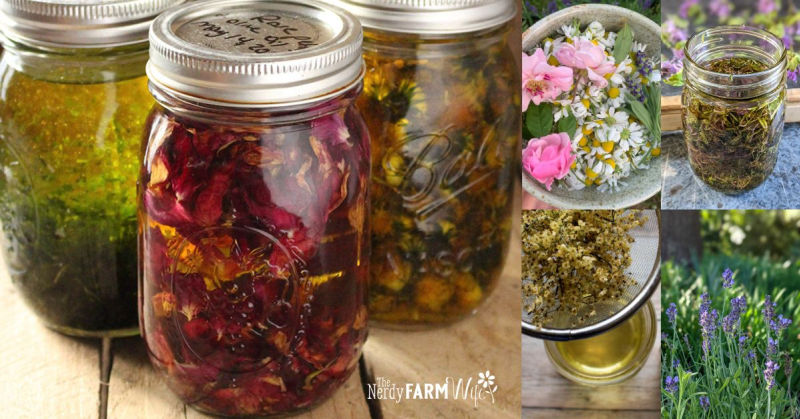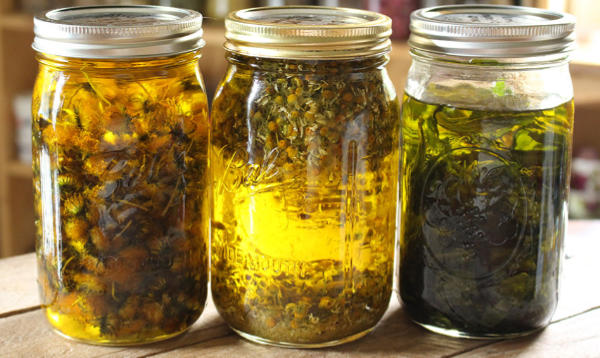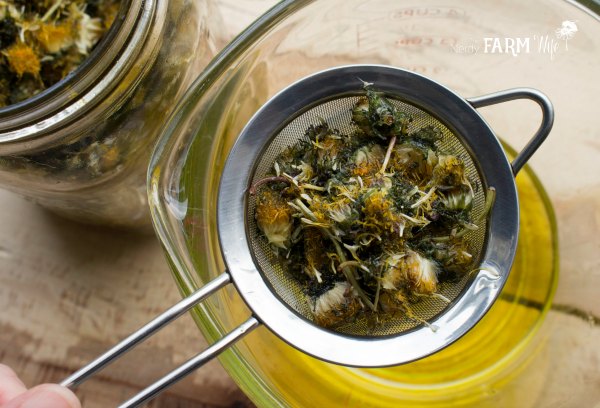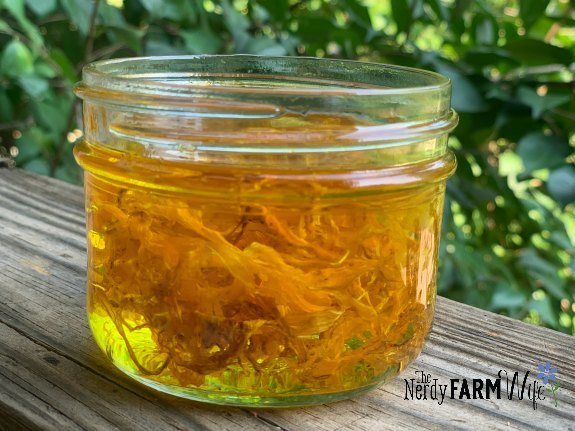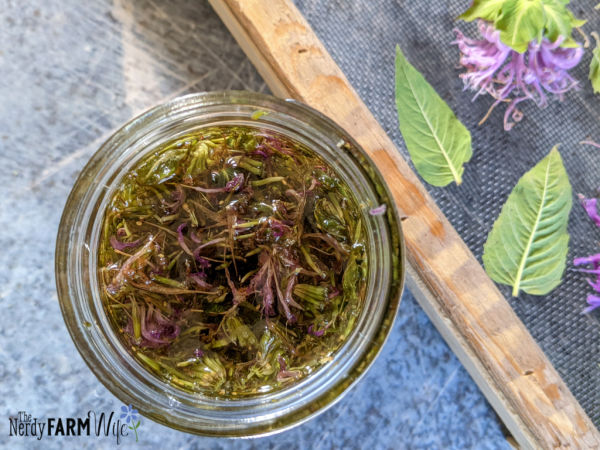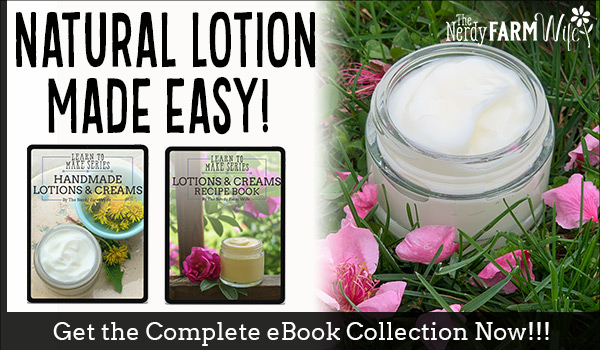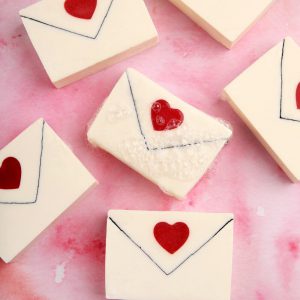Learn how to make your own herb infused oils in this step by step guide. You can then use your finished oil to make lotion bars, creams, body butters, salves, lip balms, and natural soaps!
Flowers and herbs are filled with healthy components, but to harness those benefits for skincare products such as salves, lotion bars, serums, etc., we need to first infuse them into oil.
For most herbal oil infusions, it’s recommended to use dried herbs and flowers, to avoid introducing moisture into the oil which creates cozy spots for mold and bacteria. (There are a few exceptions where it’s best to use fresh herbs, more on that below.)
RELATED ARTICLE: How to Harvest and Dry Flowers & Herbs From Your Garden
How to Make a Basic Infused Oil
I like making my infused oils using the folk method – which is a rather imprecise way that relies on natural intuition and eyeballing ingredients. This suits my style of herbalism and personality.
However, some herbalists prefer using a specific math formula, so that their infused oils stay consistent and can be easily replicated.
Both the folk method and the math formula way are explained below!
Ingredients Needed for Herb-Infused Oils:
- dried flowers and/or herbs of your choice
- half-pint or pint canning jar (mason jar), depending on how much oil you want to infuse
- carrier oil(s) of your choice (see below for a few basic oil choices)
My favorite place to buy high quality, organic ingredients is Mountain Rose Herbs, or you can check with your local health store or favorite vendor. Some links on this site are affiliate links – if you click on one and make a purchase, I earn a small commission.
Instructions for Folk Method:
- Measure out the herbs and oils and place inside the canning jar, or other heat safe container.
- If a recipe doesn’t specify how much herbs and oils to use for an infusion, fill the jar halfway with dried herbs, then add enough oil so the jar is almost filled to the top, leaving a little headroom for expansion.
- At this point, you can choose to infuse your oil using the quick heat method (2 to 3 hours), sunny window method (2 weeks), or slower traditional method (4+ weeks)
Or, The Math Formula Way
A basic ratio is 1:5 which means 1 part dried herb by weight in grams to 5 parts oil by volume in milliliters.
An example would be:
- 100 grams of dried ground lemon balm (or calendula, nettle, etc.)
- 500 milliliters oil
- Make sure your herbs are dried and crushed into small pieces.
- Weigh the herb and put it in a canning jar.
- Add the oil to the jar, stir well, and cover with a lid.
- Infuse the jar using your desired method, shaking or stirring the contents daily.
- Strain through a fine mesh sieve and store in a labeled jar.
Video: Infusing Oils
Here’s a video of me infusing some herbal oils. You can see just how easy it is to do! (Sometimes an ad plays first, but the video will start right after. The video player won’t show up if you have an adblocker.)
Three Infusing Techniques
Once you’ve sorted out the amount of herbs/flowers and oils needed, there are three main ways of infusing them together.
1. Quick Heat Method:
This technique is good if you’re in a hurry for your infused oil. However, it tends not to be as strong as a traditionally infused oil. The quick method is also used for infusing solid oils – like coconut oil (see this Whipped Dandelion & Coconut Oil Moisturizer recipe) or entire body butters (see my FREE Guide to Making All Natural Body Butters).
To infuse oil the quick way:
- Place the uncovered jar in a small saucepan containing several inches of water, forming a makeshift double boiler.
- Heat the pan over low heat for 2 to 3 hours.
- Strain out the amount of oil needed for your recipe.
- To extend the usefulness and potency of the leftover oil & herbs for future projects – top off the jar with fresh oil, cover with a lid, and infuse longer, using the sunny window method or slow traditional method.
2. Sunny Window Method:
This method takes advantage of the natural heat provided by sunshine. It works nicely for a few weeks of infusing time, but you don’t want to leave it in direct sunlight long term.
Some herbalists prefer to stick the jar of herbs and oil down into a paper lunch bag, so the infusion can benefit from the natural warmth of the sun, but won’t be exposed to direct UV rays.
To infuse oil in a sunny window:
- Cover the jar of herbs and oil with a lid (or breathable top like cheesecloth if you’re using fresh or wilted herbs) and place it in a sunny windowsill, leaving it there for two weeks. The natural heat from the sun will help infuse the oil.
- Shake the infusion once per day, or as often as you remember to.
- After two weeks, strain and use the oil, or you can move it to a darker spot and finish infusing for a few extra weeks, for a stronger oil.
- Don’t infuse for too long in the sunlight or your herbs could begin to fade and lose potency over time.
3. Slower Traditional Method:
This method takes time and patience, but it usually results in the strongest, most effective oils.
To infuse herbal oil the slower way:
- For this method, cover the jar of herbs and oils with a lid, and tuck away in a cabinet or pantry at room temperature.
- Shake the infusion once per day, or as often as you remember to.
- After 4 to 6+ weeks, strain the oil and store in a labeled jar.
How to Make Double or Triple Infusions
For a stronger product, you can infuse one batch of oil and strain. Take the strained infused oil and pour it over a second new batch of herbs in a new jar, then infuse the quick way, sunny window way, or slow way.
The herbal components from the newer herbs will be extracted into the infused oil, forming a double infusion.
If you strain that oil and do the process all over again for a third time, you create a triple infusion.
Oil Suggestions
The kind of carrier oil you use is completely up to you, however, keep in mind that different oils have differing benefits and rates of absorption.
Here are a few oil choices to consider. (I have much more detail on 45+ oils and butters, absorbency rates, benefits, and more in my Handmade Lotions & Creams eBook collection.)
Olive Oil (Olea europaea)
Extra virgin olive oil is a popular choice for infusing, since it can be used in soapmaking and all kinds of skin care products. Keep in mind though that it does have a heavy feel on your skin, so skincare products made with it will feel more oily or “greasy” than lighter oils. This might be a great thing for you if you have dry skin!
Sunflower Oil (Helianthus annuus)
Exceptional for those with sensitive or damaged skin, or those with eczema. It’s a nice neutral oil, though it is on the heavier side as far as absorbency.
Sweet Almond Oil (Prunus amygdalus dulcis)
This oil is wonderful for many skin types and has a medium absorbency rate, making it a great all purpose oil.
Coconut Oil (Cocos nucifera)
This oil gets solid when it drops below 76 degrees F, so is normally infused using the heated quick method. It also picks up the color of many yellow flowers nicely – so you can expect your dandelion infused coconut oil to have a pretty yellow color!
FAQS About Infusing Oils
Can I re-use the herbs and flowers after using them in an oil infusion?
If you use only part of the infused oil before straining it, you can top off the infusing jar with more oil & allow it to infuse again in a dark cabinet for several weeks. Don’t do this repeatedly though or you’ll end up with a weaker oil.
I forgot to strain my oil for months, is it still good?
Yes! As long as your dried herbs and flowers stayed covered by the oil, and the oil still smells good, it will be perfectly fine to strain and use. I have forgot to strain oil for almost a year before (several times in fact!) and it is always in great shape. If you used fresh herbs for the infusion though, there’s a higher chance of spoilage inside the oil.
Can I use infused oils for cooking or eating?
It’s not recommended to use these herbal infused oils for internal use. Infused oils should be applied only to your skin, and not used for food purposes.
There are instructions for safely making infused culinary herbal oil found over at the Penn State Extension Agency. These oils must be treated in special ways if you plan on ingesting them, since botulism can be a risk.
What’s the difference between infused oils and essential oils?
Essential oils are aromatic essences extracted from herbs and flowers through distillation. They have a strong aroma and are very powerful. You should always dilute essential oils and use very small amounts. A single drop can go a long way!
RELATED ARTICLE: Essential Oil Dilution Chart + Amounts to Use in Skin Care
Herb-infused oils are far less concentrated than essential oils, but they contain more whole plant extracts, not just the aromatic parts, and are safe to use in larger amounts.
Why doesn’t my oil smell like the herb or flower I used?
Many people are surprised at the lack of scent the first time they make an infused oil. If you put wonderfully scented lavender flowers into a jar to infuse, then close it up, it seems logical that the scent would transfer to the oil. However, this isn’t the case!
Most aromatic vapors are lost during the infusing process. Some, such as pine resin oil, will retain the scent, but many will not.
Don’t be alarmed, this is perfectly normal. If you’d really like to hightlight the plant’s scent in your final salve, lotion, etc, you’ll have to add that plant’s essential oil.
Should I store infused oils in the fridge?
That’s up to you. Some herbalists like to do that, but most just keep them on shelves in a cabinet or apothecary area. If you have an oil made with fresh or wilted herbs, it’s probably a good idea to store in the fridge to help the shelf life a bit.
What’s the shelf life of infused oils?
Infused oils are normally given about a one year shelf life, but this depends on what type of oil you used and whether you used dried or fresh herbs. Dried herb infusions will last longer than fresh herb infusions.
An infusion made with jojoba oil, which has a several year shelf life, should last for several years. On the other hand, an oil like grapeseed oil, which has a shorter shelf life of 6 to 9 months, may go rancid well before you expect.
As long as your oil smells good, it’s usually okay to use. If it smells like old oil or rancid though, it’s time to discard.
How can I infuse fresh herbs, like St. John’s Wort?
I have an entire article written about making St. John’s Wort oil over at my family’s site, Unruly Gardening.
Some herbalists prefer working with fresh or wilted herbs, since they feel dried herbs are less potent. In some cases, you really do need to use fresh (such as St John’s wort) since the oil is pretty useless with the dried herb.
To infuse fresh/wilted herbs:
- Pick the flowers/herbs you want to use and either infuse them right away, or spread them on a screen or paper towel for a few hours to slightly wilt them.
- Next, place them in a glass mason jar and fill the jar about 3/4 way with herb. Use a half pint jar if you only have a small amount of herbs. Use larger jars for larger batches.
- Mash, chop, or bruise the flowers or herbs to expose more surface area to the oil. I use a pair of scissors to snip directly in the jar.
- Pour your favorite oil into the jar, almost to the top. Cover the top of the jar with a piece of cheesecloth or a coffee filter secured with a rubber band – this lets extra water and moisture escape.
- Infuse for two weeks. Some herbalists like to infuse in the sunlight, while others prefer to use a heated source. Experiment with the way you like best.
- Strain and let the oil settle for a day or two. There’s often a layer of sediment that settles at the bottom of the jar.
- Carefully pour the oil into a fresh clean jar, but leave behind that sludgy residue at the bottom of the infusing jar. This will help extend shelf life.
- Store the finished oil in a cool place. Some herbalists like to store the oil in the refrigerator. Shelf life should be about 6 to 9 months, or longer. Discard right away if signs of mold, spoilage, or a bad smell develop.
Can I infuse oil with herbal powders?
Yes, just be aware that powders tend to settle at the bottom of the infusing jar and you’ll have to stir and shake them quite often. Otherwise, infuse as you normally would and strain the finished oil using a cheesecloth lined sieve to avoid gritty specks.
How do I infuse oil with resins?
Resins should be crushed and infused using a heated method to make sure they melt into the oils. I have an entire article about pine resin in which I detail how to infuse it. You would normally use these same instructions for other resins.
Can you infuse multiple herbs in the same jar?
Yes, you sure can. In fact, I like to put together unique combination infusions for many of my creations.
Here are some examples of products made with combination infusions:

